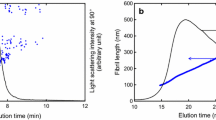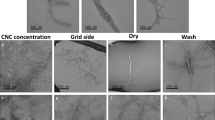Abstract
With the increased use of nanocelluloses as additives in many industrial applications, better characterization methods are needed to ensure their effectiveness. Transmission electron microscopy (TEM) is an appropriate image acquisition system to enable their morphological characterization. The use of TEM has typically been focused on determining the diameter and length of individual cellulose nanocrystals (CNCs) or nanofibers (CNFs), so different dispersion practices, such as sonication or the use of dispersants, are commonly applied to separate the particles. However, this study aims to improve the characterization of the bulk morphology of CNCs and CNFs by TEM, taking steps towards the determination of the aggregation/dispersion degree as well as the fibrillation degree of CNFs. TEM has been investigated with two types of grids (holey and Formvar/carbon), three different fixing methods (Poly-l-Lysine, glow discharge and UV radiation) and the use of negative staining. Fractal dimension and lacunarity were used to quantify the reproducibility of the improved method. With the use of Poly-l-Lysine, the attachment of CNCs and CNFs particles on the TEM grids was ensured, due to the electrostatic interactions between negatively charged nanocelluloses and positively charged and hydrophilic Poly-l-Lysine surfaces. The low value of lacunarity, close to 0.3, shows a very high reproducibility of the methodology proposed. With this new approach, the state that the nanocelluloses have in suspension can be directly characterized by TEM.
Graphic abstract








Similar content being viewed by others
References
Abitbol T, Kloser E, Gray DG (2013) Estimation of the surface sulfur content of cellulose nanocrystals prepared by sulfuric acid hydrolysis. Cellulose 20:785–794
Araki J (2013) Electrostatic or steric? Preparations and characterizations of well-dispersed systems containing rod-like nanowhiskers of crystalline polysaccharides. Soft Matter 9:4125–4141. https://doi.org/10.1039/C3SM27514K
Areid N, Peltola A, Kangasniemi I, Ballo A, Närhi TO (2018) Effect of ultraviolet light treatment on surface hydrophilicity and human gingival fibroblast response on nanostructured titanium surfaces. J Clin Exp Dent 4:78–85. https://doi.org/10.1002/cre2.108
Arias A, Heuzey M-C, Huneault MA, Ausias G, Bendahou A (2015) Enhanced dispersion of cellulose nanocrystals in melt-processed polylactide-based nanocomposites. Cellulose 22:483–498. https://doi.org/10.1007/s10570-014-0476-z
Balea A, Merayo N, Fuente E, Delgado-Aguilar M, Mutje P, Blanco A, Negro C (2016a) Valorization of corn stalk by the production of cellulose nanofibers to improve recycled paper properties. BioResources 11:3416–3431
Balea A, Merayo N, Fuente E, Negro C, Blanco A (2016b) Assessing the influence of refining, bleaching and TEMPO-mediated oxidation on the production of more sustainable cellulose nanofibers and their application as paper additives. Ind Crops Prod 97:374–387. https://doi.org/10.1016/j.indcrop.2016.12.050
Beck S, Méthot M, Bouchard J (2015) General procedure for determining cellulose nanocrystal sulfate half-ester content by conductometric titration. Cellulose 22:101–116. https://doi.org/10.1007/s10570-014-0513-y
Brinkmann A, Chen MH, Couillard M, Jakubek ZJ, Leng TY, Johnston LJ (2016) Correlating cellulose nanocrystal particle size and surface area. Langmuir 32:6105–6114. https://doi.org/10.1021/acs.langmuir.6b01376
Brito BS, Pereira FV, Putaux J-L, Jean B (2012) Preparation, morphology and structure of cellulose nanocrystals from bamboo fibers. Cellulose 19:1527–1536
Campano C, Miranda R, Merayo N, Negro C, Blanco A (2017) Direct production of cellulose nanocrystals from old newspapers and recycled newsprint. Carbohydr Polym 173:489–496. https://doi.org/10.1016/j.carbpol.2017.05.073
Chapman SK (1986) Maintaining and monitoring the transmission electron microscope, vol 8. Oxford University Press, Oxford
Chen W et al (2015) Revealing the structures of cellulose nanofiber bundles obtained by mechanical nanofibrillation via TEM observation. Carbohydr Polym 117:950–956. https://doi.org/10.1016/j.carbpol.2014.10.024
Cherhal F, Cousin F, Capron I (2015) Influence of charge density and ionic strength on the aggregation process of cellulose nanocrystals in aqueous suspension, as revealed by small-angle neutron scattering. Langmuir 31:5596–5602. https://doi.org/10.1021/acs.langmuir.5b00851
Chinga-Carrasco G, Yu Y, Diserud O (2011) Quantitative electron microscopy of cellulose nanofibril structures from eucalyptus and Pinus radiata kraft pulp fibers. Microsc Microanal 17:563–571. https://doi.org/10.1017/S1431927611000444
Cirtiu CM, Dunlop-Briere AF, Moores A (2011) Cellulose nanocrystallites as an efficient support for nanoparticles of palladium: application for catalytic hydrogenation and Heck coupling under mild conditions. Green Chem 13:288–291. https://doi.org/10.1039/C0GC00326C
Dufresne A (2012) Preparation of cellulose nanocrystals. Nanocellulose: from nature to high performance tailored materials. Walter de Gruyter, Germany, pp 117–175
Dulińska I, Targosz M, Strojny W, Lekka M, Czuba P, Balwierz W, Szymoński M (2006) Stiffness of normal and pathological erythrocytes studied by means of atomic force microscopy. J Biochem Bioph Meth 66:1–11. https://doi.org/10.1016/j.jbbm.2005.11.003
Elazzouzi-Hafraoui S, Nishiyama Y, Putaux J-L, Heux L, Dubreuil F, Rochas C (2007) The shape and size distribution of crystalline nanoparticles prepared by acid hydrolysis of native cellulose. Biomacromolecules 9:57–65. https://doi.org/10.1021/bm700769p
Fall AB, Lindström SB, Sundman O, Ödberg L, Wågberg L (2011) Colloidal stability of aqueous nanofibrillated cellulose dispersions. Langmuir 27:11332–11338. https://doi.org/10.1021/la201947x
Habibi Y, Chanzy H, Vignon MR (2006) TEMPO-mediated surface oxidation of cellulose whiskers. Cellulose 13:679–687. https://doi.org/10.1007/s10570-006-9075-y
Han X, Ye Y, Lam F, Pu J, Jiang F (2019) Hydrogen-bonding-induced assembly of aligned cellulose nanofibers into ultrastrong and tough bulk materials. J Mater Chem A 7:27023–27031. https://doi.org/10.1039/C9TA11118B
Henriksson M, Berglund LA, Isaksson P, Lindstrom T, Nishino T (2008) Cellulose nanopaper structures of high toughness. Biomacromolecules 9:1579–1585. https://doi.org/10.1021/bm800038n
Hirota M, Tamura N, Saito T, Isogai A (2010) Water dispersion of cellulose II nanocrystals prepared by TEMPO-mediated oxidation of mercerized cellulose at pH 48. Cellulose 17:279–288
Kaech S, Banker G (2006) Culturing hippocampal neurons. Nat Protoc 1:2406. https://doi.org/10.1038/nprot.2006.356
Kaushik M, Chen WC, van de Ven TG, Moores A (2014) An improved methodology for imaging cellulose nanocrystals by transmission electron microscopy. Nord Pulp Paper Res J 29:77–84. https://doi.org/10.3183/npprj-2014-29-01-p077-084
Kaushik M, Basu K, Benoit C, Cirtiu CM, Vali H, Moores A (2015a) Cellulose nanocrystals as chiral inducers: enantioselective catalysis and transmission electron microscopy 3D characterization. J Am Chem Soc 137:6124–6127. https://doi.org/10.1021/jacs.5b02034
Kaushik M, Fraschini C, Chauve G, Putaux J-L, Moores A (2015b) Transmission electron microscopy for the characterization of cellulose nanocrystals. In: Maaz K (ed) The transmission electron microscope. Theory and applications. InTech, Croatia, pp 129–164
Klemm D et al (2018) Nanocellulose as a natural source for groundbreaking applications in materials science: Today’s state. Mater Today 21:720–748. https://doi.org/10.1016/j.mattod.2018.02.001
Kvien I, Tanem BS, Oksman K (2005) Characterization of cellulose whiskers and their nanocomposites by atomic force and electron microscopy. Biomacromolecules 6:3160–3165. https://doi.org/10.1021/bm050479t
Mohraz A, Moler DB, Ziff RM, Solomon MJ (2004) Effect of monomer geometry on the fractal structure of colloidal rod aggregates. Phys Rev Lett 92:155503. https://doi.org/10.1103/PhysRevLett.92.155503
Ogawa Y, Putaux J-L (2019) Transmission electron microscopy of cellulose. Part 2: technical and practical aspects. Cellulose 26:17–34
Reichelt R, König T, Wangermann G (1977) Preparation of microgrids as specimen supports for high resolution electron microscopy. Micron 8:29–31. https://doi.org/10.1016/0047-7206(77)90005-X
Reiss MA, Lemmerer B, Hanslmeier A, Ahammer H (2016) Tug-of-war lacunarity—a novel approach for estimating lacunarity. Chaos 26:113102. https://doi.org/10.1063/1.4966539
Riddick TM (1968) Control of colloid stability through zeta potential. Livingston Wynnewood, USA
Saidane D, Perrin E, Cherhal F, Guellec F, Capron I (2016) Some modification of cellulose nanocrystals for functional Pickering emulsions. Philos Trans R Soc A 374(2072):20150139
Saito T, Kimura S, Nishiyama Y, Isogai A (2007) Cellulose nanofibers prepared by TEMPO-mediated oxidation of native cellulose. Biomacromolecules 8:2485–2491. https://doi.org/10.1021/bm0703970
Sanchez-Salvador JL, Monte MC, Batchelor W, Garnier G, Negro C, Blanco A (2020) Characterizing highly fibrillated nanocellulose by modifying the gel point methodology. Carbohydr Polym 227:115340. https://doi.org/10.1016/j.carbpol.2019.115340
Segal L, Creely JJ, Martin AE, Conrad CM (1959) An empirical method for estimating the degree of crystallinity of native cellulose using the X-ray diffractometer. Text Res J 29:786–794. https://doi.org/10.1177/004051755902901003
Stinson-Bagby KL, Roberts R, Foster EJ (2018) Effective cellulose nanocrystal imaging using transmission electron microscopy. Carbohydr Polym 186:429–438. https://doi.org/10.1016/j.carbpol.2018.01.054
Uhlig M et al (2016) Two-dimensional aggregation and semidilute ordering in cellulose nanocrystals. Langmuir 32:442–450. https://doi.org/10.1021/acs.langmuir.5b04008
Umehara S, Pourmand N, Webb CD, Davis RW, Yasuda K, Karhanek M (2006) Current rectification with poly-l-lysine-coated quartz nanopipettes. Nano Lett 6:2486–2492
Wang QQ, Zhu JY, Reiner RS, Verrill SP, Baxa U, McNeil SE (2012) Approaching zero cellulose loss in cellulose nanocrystal (CNC) production: recovery and characterization of cellulosic solid residues (CSR) and CNC. Cellulose 19:2033–2047. https://doi.org/10.1007/s10570-012-9765-6
Xu Z, Ao Z, Chu D, Younis A, Li CM, Li S (2014) Reversible hydrophobic to hydrophilic transition in graphene via water splitting induced by UV irradiation. Sci Rep 4:6450. https://doi.org/10.1038/srep06450
Yang H, Chen DZ, van de Yen TGM (2015) Preparation and characterization of sterically stabilized nanocrystalline cellulose obtained by periodate oxidation of cellulose fibers. Cellulose 22:1743–1752. https://doi.org/10.1007/s10570-015-0584-4
Young K, Morrison H (2018) Quantifying microglia morphology from photomicrographs of immunohistochemistry prepared tissue using ImageJ. J Vis Exp. https://doi.org/10.3791/57648
Acknowledgments
Authors want to acknowledge the Spanish Ministry of Economy and Competitiveness for the funding of the project CTQ2017-85654-C2-2-R, as well as the Community of Madrid for funding the RETO-PROSOST-2-CM (P2018/EMT4459). Also thanks to the Spanish National Centre of Electronic Microscopy for the support during image acquisition. Authors also want to thank Laura González Aguilera for the help in the experimental work.
Author information
Authors and Affiliations
Corresponding author
Additional information
Publisher's Note
Springer Nature remains neutral with regard to jurisdictional claims in published maps and institutional affiliations.
Electronic supplementary material
Below is the link to the electronic supplementary material.
Rights and permissions
About this article
Cite this article
Campano, C., Balea, A., Blanco, Á. et al. A reproducible method to characterize the bulk morphology of cellulose nanocrystals and nanofibers by transmission electron microscopy. Cellulose 27, 4871–4887 (2020). https://doi.org/10.1007/s10570-020-03138-1
Received:
Accepted:
Published:
Issue Date:
DOI: https://doi.org/10.1007/s10570-020-03138-1




